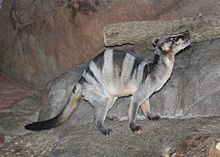Crawling cats
| Crawling cats | ||||||||||||
|---|---|---|---|---|---|---|---|---|---|---|---|---|

A selection of crawling cats |
||||||||||||
| Systematics | ||||||||||||
|
||||||||||||
| Scientific name | ||||||||||||
| Viverridae | ||||||||||||
| Gray , 1821 |
The crawling cats (Viverridae) are a feline family . They are small to medium-sized predators with around 35 species in Africa and Eurasia .
features
Civets remember at first glance to cats , but are often distinguished by the long snout, the elongated body and short limbs of these. Their fur is often characterized by a pattern of fur with ribbons and spots, but there are also monochrome types. The head is elongated, the pointed snout houses 32 to 40 teeth. The ears are small and often pointed. The short legs usually end in five toes, the claws can be retracted. In most cases, the tail is long, often bushy and has horizontal stripes or other patterns. Another characteristic of many species are the perianal glands , which can spray a pungent smelling secretion to mark their territory or to ward off enemies.
Depending on the species, crawling cats reach a head-trunk length of 35 to 95 centimeters, a tail length of 13 to 90 centimeters and a weight of 0.6 to 20 kilograms.
distribution
The clown cats reach the greatest biodiversity in South and Southeast Asia , where they are distributed from India to South China to Indonesia and the Philippines . They can also be found across Africa and the Arabian Peninsula . One species, the Kleinfleck gorse cat , is also native to southwestern Europe . Creeping cats usually live in forests, sometimes in bushland and savannahs.
Way of life
In general, crawling cats are nocturnal and sleep in tree hollows or holes in the ground during the day. Many species are good climbers and mostly live on trees, the Binturong is the only species that has developed a prehensile tail . Other species such as the civet cats , however, are found more on the ground. Two species, the Aquatic Genet and the otter civet , perform a semi- aquatic lifestyle.
Most species live as solitary animals and avoid contact with other species outside of the mating season. Some species live in pairs or small family groups; larger groups are uncommon in this family. Creeping cats are predominantly territorial animals that mark their territory with the secretion of their anal glands.
food
Sneak cats are usually omnivores . Many species are skilled hunters who sneak up on their prey or take them out of hiding by surprise. Small vertebrates are just as much a part of their diet as insects , worms and bird eggs. Some species also eat carrion . Vegetable foods such as fruits and nuts complete the menu.
Reproduction
As a rule, the female can give birth to offspring twice a year, the litter size is between one and six. Young animals are born with their eyes closed but hairy. The life expectancy for most species is likely to be between five and 15 years.
Sneak cats and humans
A number of species are used economically by humans, in particular the civet cats , from whose anal gland secretion civet was obtained, which plays an important role in perfume production . Today it is mostly made from artificial substitutes. The Fleckenmusang is known for its role in the production of Kopi Luwak coffee. The meat of some species is eaten; in the case of the larval roller , this could have been the way the SARS virus was transmitted to humans.
The main threat to the clown cats today is the loss of their habitat, especially the forest-dwelling species are affected by large-scale deforestation. Some species are considered endangered or threatened according to the IUCN .
Systematics
Creeping cats are closely related to the mongooses (Herpestidae), which were formerly part of this family, but are now viewed as a separate family from them. They belong to the feline group of predators .
The crawling cats can be divided into subfamilies and genera as follows:
- Subfamily civets (Viverrinae)
- African civet cat ( Civettictis civetta )
- Asiatic civets ( Viverra ), 4 species
- Small Indian Civet Cat ( Viverricula indica )
- Subfamily Genettinae
- Gorse cats ( Genetta ), 15 species
- Pojanas or African Linsangs ( Poiana ), 2 species
- Subfamily Palm Roller (Paradoxurinae)
- Binturong ( Arctictis binturong )
- Striped Roller ( Arctogalidia trivirgata )
- Sulawesi roller ( Macrogalidia musschenbroekii )
- Larvae roller ( Paguma larvata )
- Musangs ( Paradoxurus ), 5 species
- Subfamily Ribbon and Otter civets (Hemigalinae)
- Patch roller ( Chrotogale owstoni )
- Otter civette ( Cynogale bennettii )
- Plain roller (
- Ribbon roller ( Hemigalus derbyanus )
The African palm civet , which was formerly classed as civets, is considered representative of one's own family, Nandiniidae. Likewise, the Linsangs ( Prionodon ) today form an independent family, Prionodontidae. Several species from Madagascar, namely Fossa , Falanuk and Fanaloka , no longer count as crawling cats, but are classified as Malagasy predators (Eupleridae).
literature
- Ronald M. Nowak: Walker's Mammals of the World . 6th edition. Johns Hopkins University Press, Baltimore 1999, ISBN 0-8018-5789-9 (English).
- Wilson, DE, and DM Reeder: Mammal Species of the World . Johns Hopkins University Press, 2005, ISBN 0-8018-8221-4
Individual evidence
- ↑ Zhengli Shi Zhihong Hu: A review of studies on animal reservoirs of the SARS coronavirus. Virus Research 133 (1), April 2008; Pp. 74-87. doi : 10.1016 / j.virusres.2007.03.012 .
- ↑ Andrew P. Jennings and Geraldine Veron: Family Viverridae (Civets, genets and oyans). in Don E. Wilson , Russell A. Mittermeier : Handbook of the Mammals of the World - Volume 1 Carnivores. Lynx Editions, 2009, ISBN 978-84-96553-49-1 , p. 217.
Web links
- Rebecca Postanowicz: The Viverridae Family. Archived from the original on August 30, 2009 ; accessed on April 2, 2013 .

